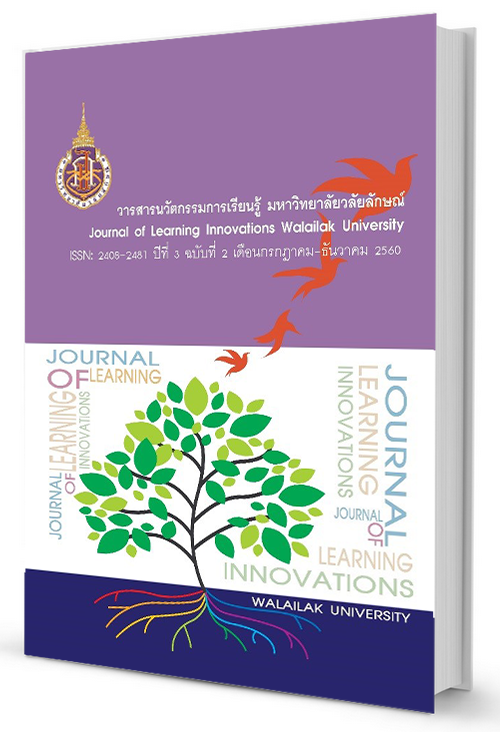Examination preparedness for the Medical Competency Assessment Test for National License step I: Pilot study
DOI:
https://doi.org/10.14456/jli.2017.11Keywords:
The medical competency assessment test for national license step I, , Self-directed learning, factors associated with scores, preparedness, mixed methods, medical educationAbstract
โครงการเตรียมความพร้อมของนักศึกษาแพทย์สำหรับการประเมินและรับรองความรู้ความสามารถในการประกอบวิชาชีพเวชกรรม ขั้นตอนที่ 1 ประกอบด้วยกิจกรรมการจัดสอบทั้งสิ้น 3 ครั้ง โดยแต่ละครั้งได้แจ้งคะแนนสอบรายหัวข้อวิชาเป็นรายบุคคลเพื่อให้นักศึกษาสามารถทบทวนศึกษาในรายวิชาที่ตนบกพร่อง
งานวิจัยนี้มีวัตถุประสงค์ คือ 1) ประเมินประสิทธิภาพการเรียนรู้ด้วยตนเอง (self-directed learning) ต่อคะแนนสอบของข้อสอบโครงการเตรียมความพร้อมนักศึกษาแพทย์สำหรับการประเมินและรับรองความรู้ความสามารถในการประกอบวิชาชีพเวชกรรม แพทยสภา ขั้นตอนที่ 1 และ 2) ระบุปัจจัยที่มีผลต่อผลคะแนนสอบของข้อสอบโครงการดังกล่าว
เป็นงานศึกษาวิจัยแบบผสมในกลุ่มตัวอย่างเป็นนักศึกษาแพทย์ชั้นปีที่ 3 สำนักวิชาแพทยศาสตร์ มหาวิทยาลัยวลัยลักษณ์ จังหวัดนครศรีธรรมราช ทั้งหมดจำนวน 48 คน วิเคราะห์คะแนนสอบของนักศึกษาแพทย์จากการสอบประเมินทั้ง 3 ครั้ง หาค่าเฉลี่ย ค่าส่วนเบี่ยงเบนมาตรฐาน ค่าร้อยละของคะแนนเต็ม และค่าสถิติ non- parametric test รวมถึงวิเคราะห์ข้อมูลเชิงคุณภาพโดยคัดเลือกนักศึกษาแพทย์แบบเจาะจงโดยเน้นสัมภาษณ์ในกลุ่มที่มีผลการเรียนดี ทำการถอดรหัสจากการสัมภาษณ์และนำมาเปรียบเทียบกัน
ผลงานวิจัยพบว่า พบว่า คะแนนของนักศึกษาแพทย์ในการสอบครั้งที่สองเพิ่มขึ้นเฉลี่ย
ร้อยละ 19.3 (95%CI 13.6-25.1) เมื่อเปรียบเทียบกับคะแนนของนักศึกษาแพทย์ในการสอบครั้งแรก และคะแนนสอบของนักศึกษาแพทย์ในการสอบครั้งที่สามเพิ่มขึ้นเฉลี่ยร้อยละ 26.2 (95%CI 18.9-33.5) เมื่อเปรียบเทียบกับคะแนนของนักศึกษาแพทย์ในการสอบครั้งแรก โดยการศึกษาเชิงคุณภาพพบว่า การทราบคะแนนสอบในแต่ละหัวข้อรายวิชาช่วยให้ประเมินตนเองได้ว่ายังบกพร่องความรู้รายวิชาใด รวมไปถึงบรรยากาศการสอบที่เสมือนจริง กระตุ้นให้มีการเตรียมตัวสอบมากขึ้น ทั้งนี้การเตรียมตัวสอบอย่างสม่ำเสมอโดยแบ่งเวลาทบทวนในแต่ละรายวิชาเป็นปัจจัยที่สำคัญที่มีผลต่อคะแนนสอบที่น่าพอใจ
References
Bonasso, P., Lucke-Wold, B., 3rd, Reed, Z., Bozek, J., & Cottrell, S. (2015). Investigating the Impact of Preparation Strategies on USMLE Step 1 Performance. MedEdPublish, 4(1). doi: 10.15694/mep.2015.004.0005
Coumarbatch, J., Robinson, L., Thomas, R., & Bridge, P. D. (2010). Strategies for identifying students at risk for USMLE step 1 failure. Fam Med, 42(2), 105-110.
Davis, G. E., & Gayer, G. G. (2017). Comparison of Basic Science Knowledge Between DO and MD Students. J Am Osteopath Assoc, 117(2), 114-123. doi: 10.7556/jaoa.2017.022
Denton, G. D., Durning, S. J., Wimmer, A. P., Pangaro, L. N., & Hemmer, P. A. (2004). Is a faculty developed pretest equivalent to pre-third year GPA or USMLE step 1 as a predictor of third-year internal medicine clerkship outcomes? Teach Learn Med, 16(4), 329-332. doi: 10.1207/s15328015tlm1604_5
Dyrbye, L. N., Satele, D., & Shanafelt, T. D. (2016). Healthy Exercise Habits Are Associated With Lower Risk of Burnout and Higher Quality of Life Among U.S. Medical Students. Acad Med. doi: 10.1097/acm.0000000000001540
Gauer, J. L., Wolff, J. M., & Jackson, J. B. (2016). Do MCAT scores predict USMLE scores? An analysis on 5 years of medical student data. Med Educ Online, 21(1), 31795. doi: 10.3402/meo.v21.31795
Ginzburg, S. B., Brenner, J., Cassara, M., Kwiatkowski, T., & Willey, J. M. (2017). Contextualizing the relevance of basic sciences: small-group simulation with debrief for first- and second-year medical students in an integrated curriculum. Adv Med Educ Pract, 8, 79-84. doi: 10.2147/amep.s124851
Giordano, C., Hutchinson, D., & Peppler, R. (2016). A Predictive Model for USMLE Step 1 Scores. Cureus, 8(9), e769. doi: 10.7759/cureus.769
Jones, V. S., Holland, A. J., & Oldmeadow, W. (2008). Inductive teaching method-an alternate method for small group learning. Med Teach, 30(8), e246-249. doi: 10.1080/01421590802259274
Jozefowicz, R. F., Koeppen, B. M., Case, S., Galbraith, R., Swanson, D., & Glew, R. H. (2002). The quality of in-house medical school examinations. Acad Med, 77(2), 156-161.
Kar, S. S., Premarajan, K. C., Ramalingam, A., Iswarya, S., Sujiv, A., & Subitha, L. (2014). Self-directed learning readiness among fifth semester MBBS students in a teaching institution of South India. Educ Health (Abingdon), 27(3), 289-292. doi: 10.4103/1357-6283.152193
Kumar, A. D., Shah, M. K., Maley, J. H., Evron, J., Gyftopoulos, A., & Miller, C. (2015). Preparing to take the USMLE Step 1: a survey on medical students' self-reported study habits. Postgrad Med J, 91(1075), 257-261. doi: 10.1136/postgradmedj-2014-133081
Levinson, M., Kelly, D., Zahariou, K., Johnson, M., Jackman, C., & Mackenzie, S. (2017). Description and student self-evaluation of a pilot integrated small group learning and simulation programme for medical students in the first clinical year. Intern Med J, 47(2), 211-216. doi: 10.1111/imj.13332
Lewin, L. O., & Lanken, P. N. (2004). Longitudinal small-group learning during the first clinical year. Fam Med, 36 Suppl, S83-88.
Monroe, K. S. (2016). The relationship between assessment methods and self-directed learning readiness in medical education. Int J Med Educ, 7, 75-80. doi: 10.5116/ijme.56bd.b282
Pai, K. M., Rao, K. R., Punja, D., & Kamath, A. (2014). The effectiveness of self-directed learning (SDL) for teaching physiology to first-year medical students. Australas Med J, 7(11), 448-453. doi: 10.4066/amj.2014.2211
Peine, A., Kabino, K., & Spreckelsen, C. (2016). Self-directed learning can outperform direct instruction in the course of a modern German medical curriculum - results of a mixed methods trial. BMC Med Educ, 16, 158. doi: 10.1186/s12909-016-0679-0
Sarko, J., Svoren, E., & Katz, E. (2010). COMLEX-1 and USMLE-1 are not interchangeable examinations. Acad Emerg Med, 17(2), 218-220. doi: 10.1111/j.1553-2712.2009.00632.x
Slocum, P. C., & Louder, J. S. (2006). How to predict USMLE scores from COMLEX-USA scores: a guide for directors of ACGME-accredited residency programs. J Am Osteopath Assoc, 106(9), 568-569.
Wang, L., Qin, P., Zhao, Y., Duan, S., Zhang, Q., Liu, Y., . . . Sun, J. (2016). Prevalence and risk factors of poor sleep quality among Inner Mongolia Medical University students: A cross-sectional survey. Psychiatry Res, 244, 243-248. doi: 10.1016/j.psychres.2016.04.011
Werner, L. S., & Bull, B. S. (2003). The effect of three commercial coaching courses on Step One USMLE performance. Med Educ, 37(6), 527-531.
Wolf, M. R., & Rosenstock, J. B. (2016). Inadequate Sleep and Exercise Associated with Burnout and Depression Among Medical Students. Acad Psychiatry. doi: 10.1007/s40596-016-0526-y
Zhang, C., Rauchwarger, A., Toth, C., & O'Connell, M. (2004). Student USMLE step 1 preparation and performance. Adv Health Sci Educ Theory Pract, 9(4), 291-297. doi: 10.1007/s10459-004-3925-x
ประกาศแพทยสภา. (2555). เกณฑ์ความรู้ความสามารถในการประเมินเพื่อรับใบอนุญาตเป็นผู้ประกอบวิชาชีพเวชกรรม พ.ศ. 2555 Retrieved 6 May 2017, from https://www.tmc.or.th/file_08062012.pdf
Downloads
Published
How to Cite
Issue
Section
License
เนื้อหาและข้อมูลในบทความที่ลงตีพิมพ์ในวารสารนวัตกรรมการเรียนรู้ มหาวิทยาลัยวลัยลักษณ์ ถือเป็นข้อคิดเห็นและความรับผิดชอบของผู้เขียนบทความโดยตรง ซึ่งกองบรรณาธิการวารสาร ไม่จำเป็นต้องเห็นด้วย หรือร่วมรับผิดชอบใดๆ
บทความ ข้อมูล เนื้อหา รูปภาพ ฯลฯ ที่ได้รับการตีพิมพ์ในวารสารนวัตกรรมการเรียนรู้ มหาวิทยาลัยวลัยลักษณ์ ถือเป็นลิขสิทธิ์ของวารสารนวัตกรรมการเรียนรุ้ มหาวิทยาลัยวลัยลักษณ์ หากบุคคลหรือหน่วยงานใดต้องการนำทั้งหมดหรือส่วนหนึ่งส่วนใดไปเผยแพร่ต่อเพื่อกระทำการใดๆ จ้อต้องได้รับอนุญาตเป็นลายลักษณ์อักษรจากวารสารนวัตกรรมการเรียนรู้ มหาวิทยาลัยวลัยลักษณ์ก่อนเท่านั้น

